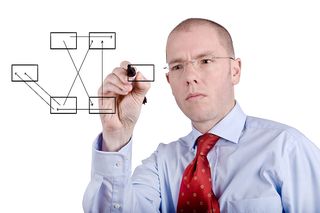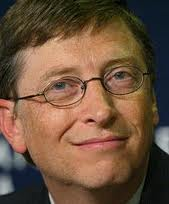 “Your most unhappy customers are your greatest source of learning." –Bill Gates
“Your most unhappy customers are your greatest source of learning." –Bill Gates
- He is the son of William H. Gates and Mary Maxwell Gates and was born in Seattle, Washington. His father gave him the nickname Trey.
- He started working with computers during the 8th grade when the school he attended purchased a 33 ASR system, which he spent most of his free time working on.
- While still in high school, he was hired to write a payroll program in COBOL for Information Sciences, Inc.
- Once his high school administration learned about his computer programming skills, he was asked to develop a student scheduling application; he scheduled himself in classes with the majority being girls.
- His dream was to place a computer on the desk of every businessman worldwide.
- He dropped out of Harvard University after his sophomore year to start a company that developed a BASIC interpreter for the Altair 8800 in 1975.
- He licensed the first copy of DOS as the operating system for IBM from Seattle Computer Products and modified the product for personal computers and renamed it PC-DOS.
- His management style was straight forward and demanding. He led by example as CEO and Chief Architect of one of the world’s largest software development companies.
- Although his main role was to focus on managing the organization between 1975 and 1989, he was also a hands-on developer focusing mostly on developing the language software that developers used to write their code.
- He and his wife created a foundation that has contributed billions to charitable organizations and scientific research programs.
Free Assessment
Who is Bill Gates?

7 Things We Can Learn From Bill Gates About Innovation.
- Innovation starts with great education. In 2003, American high school students marked 23 out of 29 compared to the other first world countries. To develop a strong culture of innovation, individuals and organizations must continuously develop themselves through reading and learning from others.
- Technology can help spread innovation. With the explosion of online learning sites, collaboration portals, Wikipedia and too many other sites to mention, technology has and will continue to transform the world economy and landscape. Information and knowledge that once was not accessible can easily be found with just the click of the mouse on Bing or Google. As technology streamlines, those who are affected will be required to change careers and/or learn new skills that may be obtained using these newer technologies.
- Having a partner makes the workload lighter. According to an article titled “Bill Gates making his breakthrough as a conceptual innovator, age 19,” the writer states, “When Gates was 19 and Allen was 22, they started ‘the world’s first microcomputer software company’ and wrote the Altair software in five weeks in Gates’ dorm room. Then they flew to MITS offices in Albuquerque, N.M., to show off what they had done. They won the MITS contract with MITS and soon moved to Albuquerque to continue the work. Gates dropped out of Harvard; they registered their new company in New Mexico as ‘Microsoft,’ and soon had sold their BASIC software to NCR and Intel too” (Source: http://www.artsofinnovation.com/gates.html).
- Thinking “BIG” forces you to innovate. In his article on the Huffington Post Blog, Bill Gates encourages the nations to focus on reducing CO2 emissions to 80% by 2050 instead of 30% by 2025. To reduce CO2 emissions by 80% will require a totally different way of thinking about the process of reducing CO2 in transportation and within the electrical power generation sectors. Countries, universities, and scientists will need to think differently about how they will produce power in the future to achieve this goal. To achieve the goal of reducing CO2 emissions to 80% in 2050 will require that the transportation and electrical sectors reduce their CO2 emissions to zero; this will require innovative thinking.
- Combining 2 or 3 old ideas to create a new idea. Gates separated the PC operating system from the computer’s hardware to create a new way of delivering PC software and help to organize the computer industry in the late 1970s.
- Invest in young people within your community. Bill Gates is putting his money behind his desire to see innovation proliferate. An article posted in October 2010 reveals Bill and Melinda Gates’ plans to donate $20 million to help community college students. According to Chris Dawson, “The community college programs are expected to supplement and differentiate in-class instruction and ensure that more students are motivated to pursue post-secondary education by focusing their efforts on classes that meet their technical and professional needs” (Source: http://www.zdnet.com/blog/education/bill-gates-and-education-innovation-is-your-only-hope/4268).
- Talk to other about the importance of Innovation.
References
- “How to Keep America Competitive” by Bill Gates: http://www.washingtonpost.com/wp-dyn/content/article/2007/02/23/AR2007022301697.html
- "Bill Gates: Innovation Key To Helping Poor; He Takes Questions On NPR Today”: http://www.npr.org/blogs/thetwo-way/2010/01/bill_gates_letter_innovation_t.html
- “Bill Gates making his breakthrough as a conceptual innovator, age 19”: http://www.artsofinnovation.com/gates.html
- Why We Need Innovation, Not Just Insulation: http://www.huffingtonpost.com/bill-gates/why-we-need-innovation-no_b_430699.html
- Bill Gates: The Seer From Seattle: http://www.businessweek.com/magazine/content/04_46/b3908015_mz072.htm
Principles of Execution Key Concepts:
- Bill Gates
- Innovation
- Continuous Improvement
Share your ideas or thoughts!

